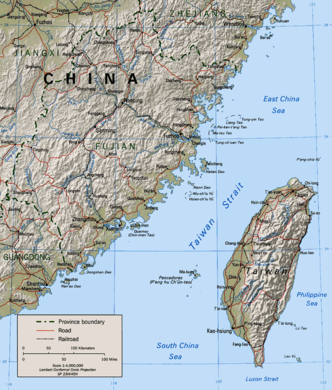Third Taiwan Strait Crisis
| Third Taiwan Strait Crisis | |||||||
|---|---|---|---|---|---|---|---|
 Taiwan Strait |
|||||||
|
|||||||
| Belligerents | |||||||
|
|
|
||||||
| Commanders and leaders | |||||||
|
|
|
||||||
| Units involved | |||||||
|
|
|
||||||
| Strength | |||||||
|
|
|
||||||
The Third Taiwan Strait Crisis, also called the 1995–1996 Taiwan Strait Crisis or the 1996 Taiwan Strait Crisis, was the effect of a series of missile "tests" conducted by the People's Republic of China (PRC) in the waters surrounding Taiwan including the Taiwan Strait from July 21, 1995, to March 23, 1996. The first set of missiles fired in mid-to-late 1995 were allegedly intended to send a strong signal to the Republic of China (ROC, commonly known as "Taiwan") government under Lee Teng-hui, who had been seen as moving ROC foreign policy away from the One-China policy. The second set of missiles were fired in early 1996, allegedly intending to intimidate the Taiwanese electorate in the run-up to the 1996 presidential election.
The crisis began when President Lee Teng-hui accepted an invitation from his alma mater, Cornell University to deliver a speech on "Taiwan's Democratization Experience". Seeking to diplomatically isolate the Republic of China, the PRC opposed such visits by ROC (commonly known as Taiwan) leaders. It argued that Lee harbored pro-Taiwan independence sentiments and was therefore a threat to stability in the region. A year earlier, in 1994, when President Lee's plane had stopped in Honolulu to refuel after a trip to South America, the U.S. government under President Bill Clinton refused Lee's request for a visa. Lee had been confined to the military airfield where he landed, forcing him to spend a night on his plane. A U.S. State Department official called the situation "embarrassing" and Lee complained that he was being treated as a second-class leader.
After Lee had decided to visit Cornell, U.S. Secretary of State Warren Christopher assured PRC Foreign Minister Qian Qichen that a visa for Lee would be "inconsistent with [the U.S.'s] unofficial relationship [with Taiwan]." However, the humiliation from Lee's last visit caught the attention of many pro-Taiwan figures in the U.S. and this time, the United States Congress acted on Lee's behalf. In May 1995, a concurrent resolution asking the State Department to allow Lee to visit the U.S. passed the House 396 to 0 with 38 not voting, and the Senate 97 to 1 with 2 not voting. The State Department relented on May 22, 1995, and the PRC condemned the U.S. for "ruining" Sino-American relations.
...
Wikipedia
